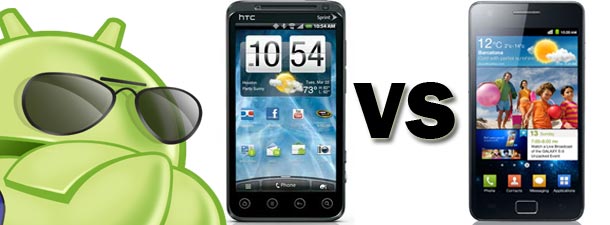
Alright fellow Android Superphone followers, here it finally is – Android Authority’s Extreme Superphone Standoff: the Samsung Galaxy S II vs. the HTC EVO 3D. We review and compare all of the important areas below. Read on to find out which one is the victor!
Form & Design
Aesthetically, we have to say they are both remarkable looking devices. To think how far we have come in such a short amount of time is nothing short of remarkable. The trend towards slender, svelter, long and angular designs looks, to us, both modern, and futuristic. While some will consider both devices too large for everyday use, they most likely aren’t reading this page. Either way, we really think Samsung has hit it out of the park design wise with the Galaxy S II, and it is also the thinner of the two. Additionally, it is considerably lighter when compared to the the HTC EVO 3D, and so for all the reasons we could think of – we will handily give it to Samsung this round.Score:
HTC EVO 3D: 8.8/10Samsung Galaxy S II: 9.4/10
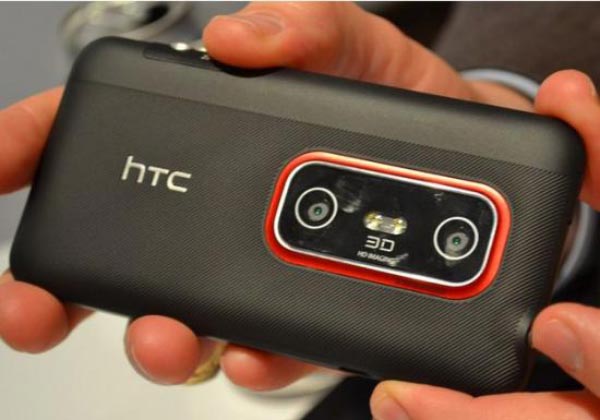
The HTC EVO 3D has dual 5 megapixel cameras for 3D recording capabilities
Processor & Performance
Undeniably, both the Samsung Galaxy S II and the HTC EVO 3D are two of the most powerful smartphones in the world. The HTC EVO 3D features a 1.2GHz Qualcomm MSM8660 dual-core processor running on the Snapdragon chipset, and contains an Adreno 220 graphics processing unit (GPU), versus the Samsung Galaxy S II’s Cortex A9 1.2GHz dual-core and Mali 400MP .Truth be told, the HTC EVO 3D phone is lightning fast, but the Samsung Galaxy S II is on a whole new level of performance. In terms of future proofing, both devices are ahead of their peers substantially, with the Samsung Galaxy S II taking the crown. Whether you opt for the Samsung Galaxy S II or the HTC EVO 3D, you will certainly have hardware 1powerful enough for any app or game you throw at it.of. The same exists for the operating system itself, with Android 2.3 Gingerbread not having the code necessary to take advantage of dual core processing quite yet. Thankfully we have been assured that Android 2.4 will remedy this very soon, and owners of these incredible devices will likely see a significant performance ‘snap’ in the right direction. The new dual-core Snapdragons are extremely powerful processor setups and we have to commend HTC for choosing them for their 3D handset, the HTC EVO 3D.
At the same time, Samsung has also done an incredible job with their choice of processor too. The Galaxy S II contains a 1.2GHz dual core ARM Cortex-A9 under the Orion chipset, together with a Mali-400MP GPU. Just like what we wrote for the HTC EVO 3D above – the same stands true. Furthermore, it should be noted that both phones have 1GB of RAM on board, whih is quickly becoming the industry standard for Superphones going forward. Really, the only difference is that the HTC EVO 3D will have 2 cameras to function simultaneously to take advantage of its herculean hardware, as well as a higher resolution screen. Either way, the Samsung Galaxy S II will certainly not even break a sweat with even the most demanding applications, including recording full 1080p video at 30 frames per second, rendering of flash, and playing the latest games. Certainly, the same stands true in terms of hardware that is likely to stand the test of time for the foreseeable future, which, in the world of mobile technology, is approximately 6-12 months.
Still the Samsung Galaxy S II’s combination of Cortex A9 1.2GHz dual core and Mali 400MP is substantially faster than the HTC’s set up. Recent benchmarks reflect this. I would hazard a guess to say that the Galaxy S II is currently the fastest phone in the world, and that’s without the modding community being able to get their hands on it yet.
Score:
HTC EVO 3D: 9.2/10Samsung Galaxy S II: 9.6/10
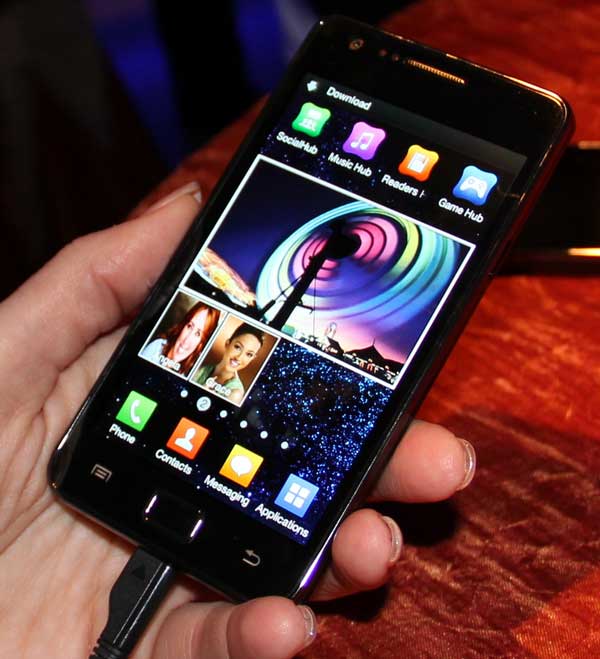
The Samsung Galaxy S II features an industry leading Super AMOLED Screen
Not too long ago, phones with 64MB or even 256MB of storage on board were considered blessed among smartphones – but not anymore. The EVO 3D has two options for onboard storage – being offered in either 1GB or 4GB variants. Not bad, not bad. Unfortunately, when compared to the mammoth 16GB or 32GB offerings of the Samsung Galaxy S II line, it becomes a no-brainer. Still, 4GB of memory for applications is a shocking amount of storage space for applications.
Both amazing devices come with the standard support for micros SD of up to 32GB, which makes them devices with a substantial amount of potential data storage. Either way, Apps2SD will soon be a thing of the past thanks to the gigantic amount of on-board storage on the Samsung Galaxy S II.
This comparison isn’t really fair, but we had to include it for posterity.
Score:
HTC EVO 3D: 8.5
Samsung Galaxy S II: 9.3

The HTC EVO 3D has a qHD 960x540 resolution display
3D is something that the HTC EVO 3D was built to do, and it actually does it quite well. With a pair of 5-megapixel cameras, capturing everything at 2560х1920 pixel resolution, it’s actually a great feature to have. While 3D TV’s have yet to gain mainstream acceptance, and there is potential that they never will – it’s still an interesting novelty to have, and gives you bragging rights at least.
More importantly however, is the fact that the Samsung Galaxy S II can capture 1080p video with its 8MP rear camera, while the HTC EVO 3D is only capable of capturing 720p in 3D, but can do 1080p in 2D. In this case, it’s nice to have the option to be able to record either 3D or 2D. Furthermore, the HTC EVO 3D features a 1.3 megapixel front facing camera, which is more than sufficient for day to day video chats, but isn’t quite up to the same standard as the front facing 2 megapixel on the Samsung Galaxy S II. The real difference for most people though, will be the fact that the Galaxy S II is capable of recording video at a silky smooth 30fps, while the EVO 3D is only capable of 24FPS. If you’ve ever seen the difference, you will know what I am talking about. Especially considering that we are talking about 1080p video, the results could be even more striking.
Samsung, like most of the other manufacturers, chose not to include any 3D functionality. Opting for raw ’2D’ (sounds so 2010 now) power, the Galaxy S II captures images at 8 megapixel, with a 3264×2448 pixel resolution and handily does video at 1080p. The additional camera features are fairly comprehensive with autofocus, LED flash, touch focus, geo-tagging, image stabilisation and both face and smile recognition.
Really actually, this is a tough call. Certainly, if you are at all intrigued by 3D, than the HTC EVO 3D is the way to go. If, however, you are a ’2D purist’, and would rather opt for higher quality stills and much better 1080p video, then we would suggest the Samsung Galaxy S II.
Score:
HTC EVO 3D: 9.2
Samsung Galaxy S II: 9.6
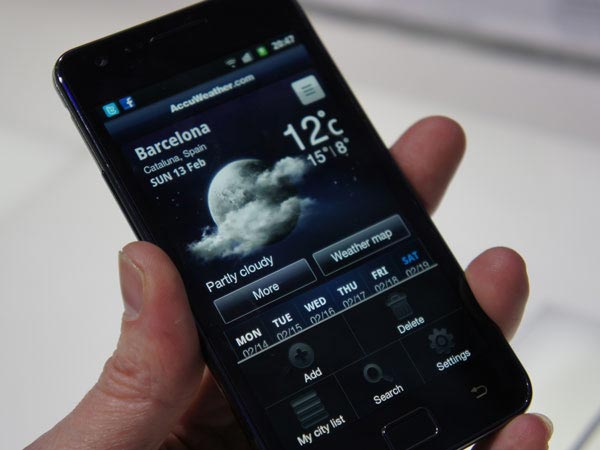
Display
Now this is where things get really interesting, and we actually had quite a discrepancy here at Android Authority between the Editors over this one. Essentially we are looking at two 4.3 (Samsung’s is 4.27 inches) inch state of the art display technologies, with the HTC EVO 3D featuring a 4.3-inch capacitive LCD touchscreen at 540×960 qHD resolution with multi-touch input, versus the Samsung Galaxy S II’s own Super AMOLED Plus capacitive touchscreen measuring in at 4.27-inches with a lower resolution of 480×800 pixels.Now, we were taken aback by the sheer brilliance of Samsung’s Super AMOLED Plus display technology – it really is in a class of its own. The pictures we have here won’t do it justice, but we can assure you it will leave you entranced, and will handily display everything you throw at it beautifully, and be viewable even in bright, direct sunlight. Oh, and it has Gorilla Glass too, which is simply as good as it gets in terms of scratch protection for your new baby.
So essentially we are looking at the higher resolution 3D display of the HTC EVO 3D versus the lower resolution display of the Samsung Galaxy S II. We will have to leave this up to you, but our hearts wain whenever we think of the Galaxy S II – it’s just so hypnotic to look at, and to know it uses less power and displays more vivid colors is enough to seal the deal for us.
Score:
HTC EVO 3D: 9.2
Samsung Galaxy S II: 9.4
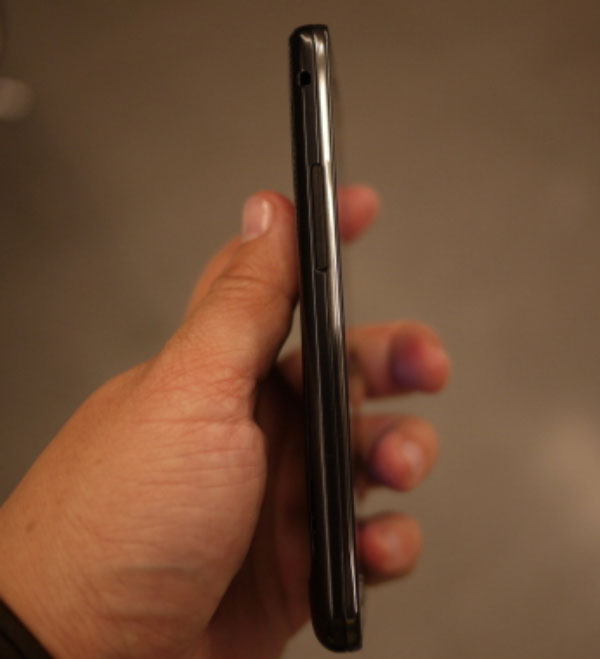
Final Thoughts
Folks, we are living at the beginning of a true hardware mobile revolution. We are just beginning to get a glimpse of the latest Superphones – and these two represent the most powerful, most advanced smartphones in the world. While their approaches are different, and they will certainly appeal to different consumers, we feel like both are a safe choice. Both contain incredibly fast hardware, amazing screens, beautiful, high quality cameras, and represent the best of the best in virtually every area of note.So, to make it easy for you – if you just want an incredibly powerful smartphone with an amazing camera, incredible performance that bests any other phone that we know of, and tons of storage space with one of the best looking and slimmest designs on the market, than the Galaxy S II is the phone for you. If you are a big fan of 3D, and don’t really care too much about having the most powerful hardware on the market, then would would suggest going for the HTC EVO 3D.
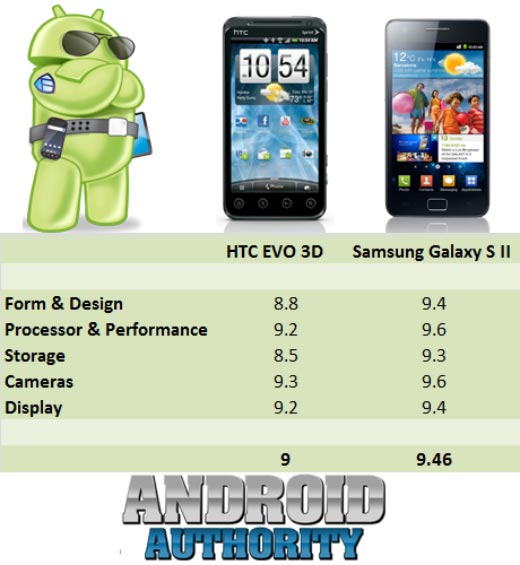
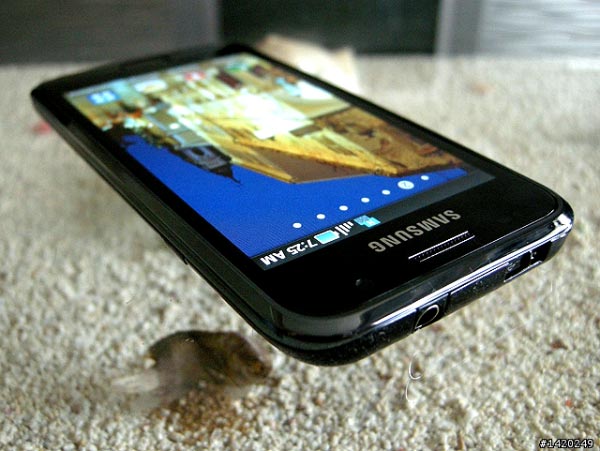
No comments:
Post a Comment